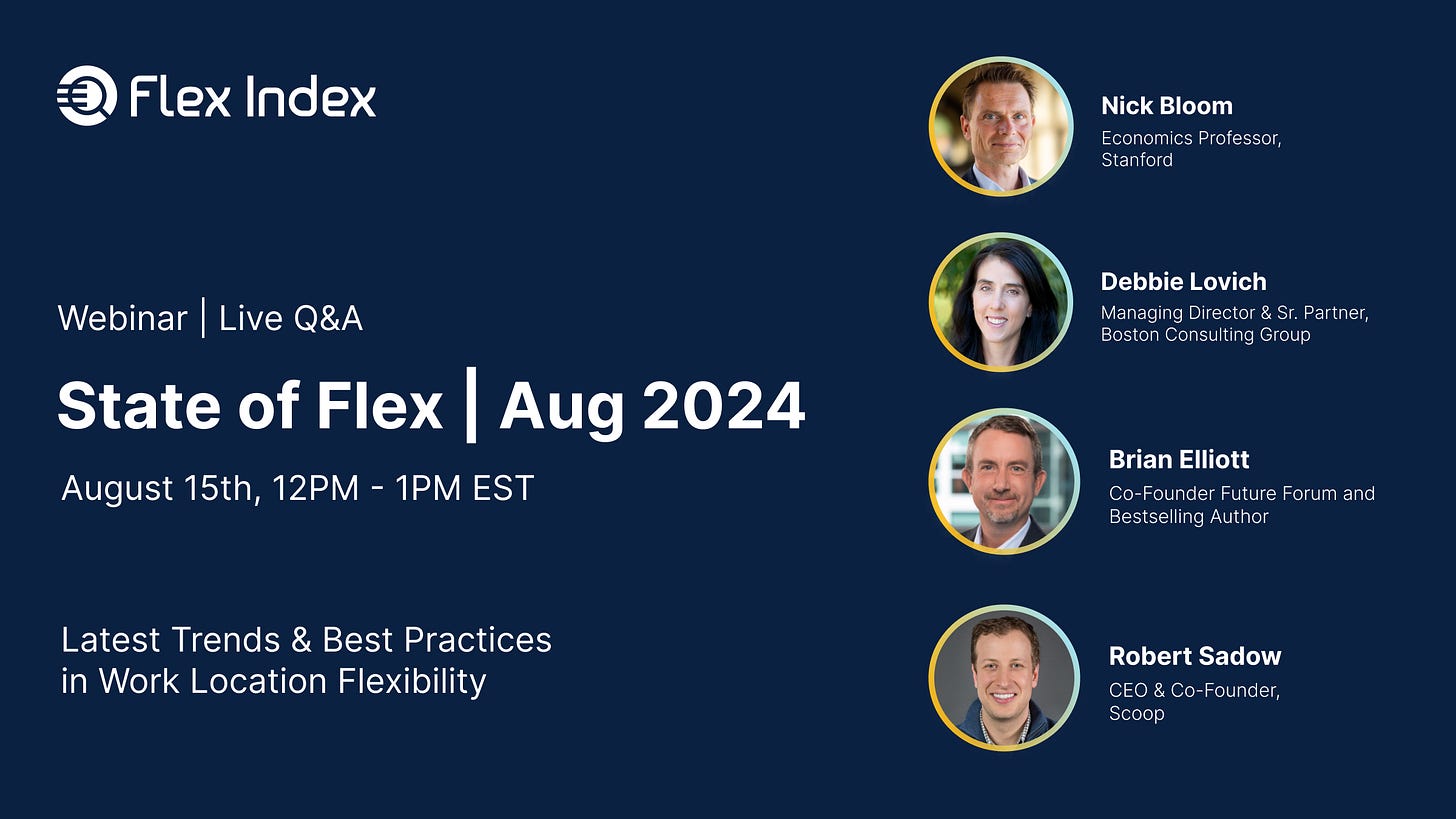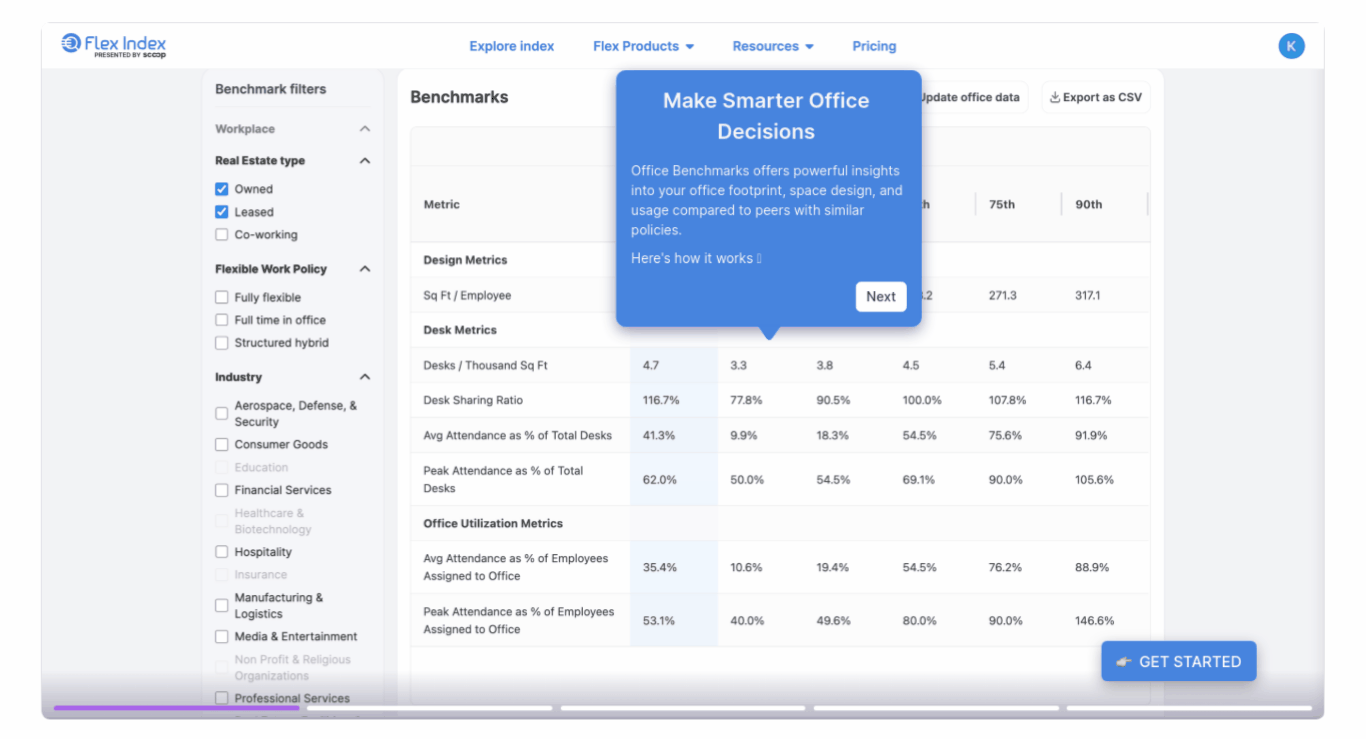Is Time the Next Frontier of Flexibility?
Plus, flexible work's impact on families, careers, and urban spaces with Matthew Kahn
👋 Happy Tuesday! When it comes to workplace flexibility, the compass points West and East! Massachusetts has a whopping 89% of companies offering work location flexibility. While coastal states dominate the top 10, Illinois stands out as the Midwest's lone representative, with 84% of its companies embracing the flexible work trend.
In this week’s edition:
🎥 On-Demand State of Flex Recording
⏰ Time Flexibility on the Rise
🧠 Migating Burnout at Work
Current Subscribers: 6,905
Please forward to colleagues and friends! Link to subscribe.
FLEX EVENTS 📅
On-Demand State of Flex Webinar Now Available
In our Q3 State of Flex webinar, Rob Sadow (Flex Index), Nick Bloom (Stanford), Debbie Lovich (BCG), and Brian Elliott (Future Forum) delved into the latest data, insights, and trends in the ever-evolving landscape of workplace flexibility.
Here’s a sneak peek of what you’ll learn from the on-demand session:
The latest breakdown of work location flexibility approaches within the United States
The increasingly critical role of internal events to drive engagement in hybrid work
Creating a "phygital" work environment to meet Gen Z's unique hybrid needs
The universal impact of workplace joy on reducing attrition risk for all worker types
Access the on-demand recording by following the link below 👇
THIS WEEK’S FLEX FOCUS 🔍
The New Workplace Flexibility: Time, Not Just Place
In the post-pandemic work landscape, a new trend is emerging: employees are seeking flexibility not just in where they work but when they work. Recent data from Flexa reveals a growing demand for "core hours" arrangements and jobs offering "a little flexibility" in start and end times.
This shift reflects a broader change in workplace dynamics, with a focus on asynchronous work and output-led management. While the remote work debate continues, the emphasis on flexible hours is gaining momentum, reshaping our understanding of productivity and work-life balance.
However, a gap exists between employee desires and employer offerings. As demand for flexible hours rises, job vacancies offering such arrangements have decreased. This presents both a challenge and an opportunity for employers in the talent market.
FLEX WORK QUICK HITS 💥
Stay ahead of the curve with our curated roundup of the trending flexible work stories making waves right now. Here's what you need to know 👇
AllWork: Structured Hybrid work models dominate U.S. workplaces in Q3 2024, with 38% of companies adopting this approach and an average of 2.63 required office days per week.
Forbes: Hyatt Hotels is evolving its HR practices, focusing on skills-based hiring and increased flexibility for both office and frontline workers.
WSJ: Starbucks’ new CEO Brian Niccol won’t be required to relocate to Seattle, instead commuting from California, where the company will set up a remote office.
Psychology Today: Companies embracing flexible work arrangements outperform their office-based counterparts, with remote-flexible firms experiencing 16% higher revenue growth from 2020 to 2022.
STAT OF THE WEEK 📈
Avg. Required Time In Office / Week Increased QoQ
The average US firm requires 2.63 days per week in the office, up from 2.59 days a quarter ago. That average is the same whether we look at all US firms or just Structured Hybrid firms.
FLEXPERT INSIGHTS 🧠
Mitigating Burnout: The Power of Clarity and Impact
In today's high-pressure work environment, Tonille Miller proposes two key strategies to combat burnout: increasing clarity and showcasing impact.
By clearly defining organizational vision, roles, and goals, leaders provide direction and purpose, allowing employees to channel their energy efficiently. Equally crucial is emphasizing impact. Miller contends that burnout stems from a perceived lack of value, not work volume. Eliminating low-value tasks, showcasing results, and aligning tasks with strengths fosters meaningful contributions.
Ultimately, Miller reminds us that prioritizing employees' psychological and emotional needs is essential for true organizational success and productivity.
FLEX PERSPECTIVES 🎙️
Flexible Work’s Impact on Families, Careers, and Urban Spaces | Matthew Kahn
In this episode of Flex Perspectives, Rob Sadow is joined by Matthew Khan, Provost Professor of Economics at the University of Southern California and Visiting Fellow at the Hoover Institution.
Join us as we discuss:
The imperative for cities to rethink their strategies in the face of remote work
The implication of remote work for the labor force participation of working mothers
How local politics influences hybrid work policies
Also available on Apple Podcasts.
COMPANY SPOTLIGHT ⭐️
Printify, founded in 2015, is a leading e-commerce print-on-demand service that links merchants with top print providers around the globe. Printify’s team collaborates to achieve success and celebrate victories as one. These core values ensure that all employees, no matter where they are, contribute meaningfully and are recognized and rewarded for their efforts.
ONE MORE THING 1️⃣
Add your company to Flex Index
Learn about Office Benchmarks
Share this newsletter with friends and colleagues
FLEX INDEX | OFFICE BENCHMARKS
Office Benchmarks offers powerful insights into your office footprint, space design, and usage compared to peers with similar policies. Maximize your workplace potential and make confident, informed investments.









With MapMyFlex we created the flexibility triangle where flexibilty based around 3 variables:
- time (hours per day)
- location (where you work from )
- duration (days per week/month/year)
And based on that we created a tool that allows professionals and employers to create their own flexible working profiles. Creating charts for time flex, location flex, duration flex and an overall full flex.
If you'd like to try it out - www.flexpertae.com
If you like to find out more feel free to reach out to me https://www.linkedin.com/in/zahida-c-phd-9104551/